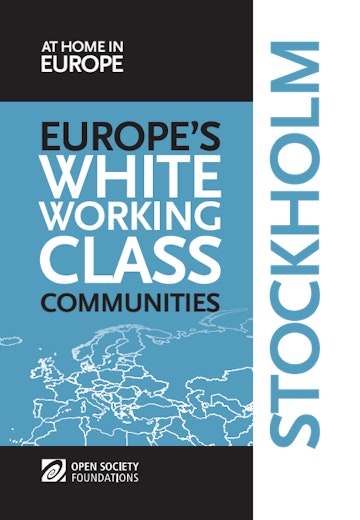Lessons from the White Working Class Community in Stockholm
By Antonia Zafeiri
Botkyrka—in Greater Stockholm—is the first municipality in Sweden where the majority population is no longer the majority locally but the largest demographic among many minorities. Southern Botkyrka was the focus of Open Society’s At Home in Europe report on white working class communities in Stockholm. The report’s authors, Tobias Hübinette and Charlotte Hyltén-Cavallius of the Multicultural Centre in Stockholm, spoke to us about their findings.
How are current demographic changes in Sweden affecting majority Swedes’ sense of identity?
Like in other Western countries, the population of ethnic minorities in Sweden is increasing and their average age is younger than that of white majority Swedes. Swedes feel this demographic transition in their daily lives, but there are no exact statistics to inform them of this trend. This general feeling that the white majority population is decreasing, both in absolute numbers and proportionally, has generated feelings of insecurity among the majority population about the future.
There is still an entrenched and firm view of who is a Swede and what constitutes the Swedish way of life stretching back to the last century. On an official and statistical level a Swede is someone who is born in Sweden with one or both parents also born in Sweden and has Swedish citizenship. According to public perceptions there is a combination of cultural practices, societal values, language, religion, tradition, cultural heritage, appearance, and dress code, as well as certain ways of active participation in civil society which are considered to be “Swedish.”
This established view makes it hard for majority Swedes to adjust to the increasing diversity of the Swedish population. The perception that minorities are hostile to Swedish values and way of life has become a major impediment to their inclusion in Swedish society.
Why did you choose Botkyrka for this study, and can the findings be applied to other areas in Sweden?
Botkyrka is one of the most segregated municipalities in the country and a stronghold for ethno-nationalistic parties, until now unpopular in the capital region. It is also the first of now several municipalities where majority Swedes are no longer the majority but the biggest fragment among many minorities. Botkyrka may stand as a unique case right now but its transition is representative of what will happen in several other municipalities in the coming years. Through our research and recommendations on Botkyrka we want to offer an insight into the future of urban Sweden.
The Swedish prime minister has recently called on Swedes to “show tolerance” to the increasing number of refugees, including Syrians and Iraqis, arriving in Sweden. What role can local municipalities play in addressing the exclusion felt by majority Swedes?
Today Sweden does take in more refugees than any other Western country, but this has not yet affected the lives of most majority Swedes. It is still the same municipalities, such as Botkyrka, which receive most of the newcomers, and the vast majority end up in segregated areas. However, it is generally accepted that there is an economic cost associated with all this, which is something the prime minister has underlined during this election campaign.
The overarching message coming from our research is that municipalities should not focus solely on minorities and their neighborhoods when discussing issues of integration and social cohesion. They should make sure they include majority Swedes in those discussions and address their concerns. Some problems are also better solved at the local level. For example, segregation between North and Southern Botkyrka is even more pronounced because of separate public transport systems—which are largely the result of management at the country level.
How is Sweden different from other countries in Europe when it comes to the marginalization of majority communities?
Sweden was not hit as hard by the latest financial crisis in Europe. Therefore, the major difference with other European countries is that the absolute majority of white Swedes are doing well in socioeconomic terms. There are of course individual cases where majority Swedes are less privileged but, overall, urban areas where they prevail in numbers have positive economic indicators. Majority Swedes’ biggest worry is an existential one relating to the future of their national identity.
Until April 2016, Antonia Zafeiri was a European communications officer at the Open Society Foundations.
